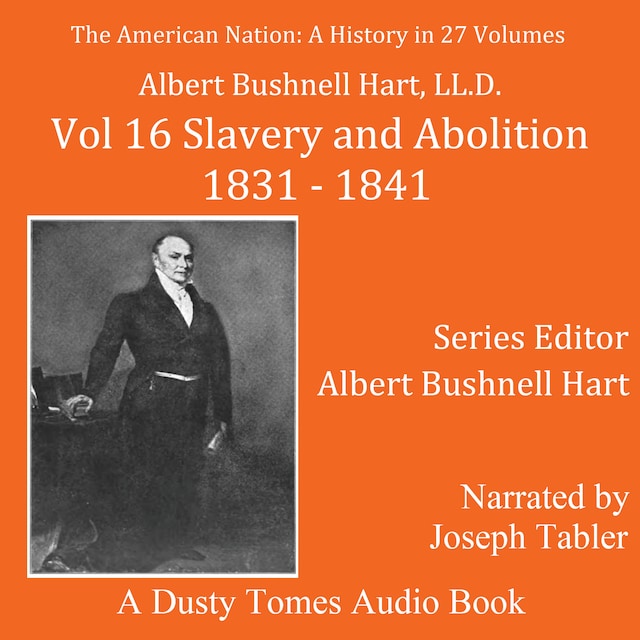
The American Nation: A History, Vol. 16
Slavery and Abolition 1831–1841
Description of the book
A Dusty Tomes Audio BookIn Cooperation with Spoken Realms
Slavery and Abolition 1831–1841 by Albert Bushnell Hart, LLD. Professor of History at Harvard University. Published in 1906 by Harper and Brothers.
Narrated by Joseph Tabler. This book is in the public domain. It is read ‘as written.'
Narrator’s Note: an excellent book! Quite smart and thorough. Well written by the Editor of the Series.
Volume 16 of 27 in The American Nation: A History From Original Sources by Associated Scholars published by Harper Brothers (1904–1918). Edited by Albert Bushnell Hart, Professor of History at Harvard University.
In the Editor’s Introduction to the series: That a new history of the United States is needed, extending from the discovery down to the present time, hardly needs a statement. No such comprehensive work by a competent writer is now in existence. Individual writers have treated only limited chronological fields. Meantime there is a rapid increase of published sources and of serviceable monographs based on material hitherto unused. On the one side, there is a necessity for an intelligent summarizing of the present knowledge of American history by trained specialists; on the other hand, there is a need for a complete work, written in an untechnical style, which shall serve the instruction and the entertainment of the general reader.
From the Author’s Preface: Except perhaps the struggle between patriots and tories at the outbreak of the Revolution, no controversy in the history of the United States has aroused such passion and led to such momentous results as that between the advocates and the opponents of slavery … The book has the double purpose of describing the conditions of slavery and the state of mind of those interested in it or against it, and at the same time recording the events which mark the anti-slavery agitation.
It is hard for a son and grandson of abolitionists to approach so explosive a question with impartiality, but the book is intended to show that there was more than one side to the controversy and that both the milder form of opposition called antislavery and the extremer form called abolition were confronted by practical difficulties which to many public-spirited and conscientious men seemed insurmountable.
CONTENTS:Author’s PrefaceI. American Social Characteristics (1830–1860)II. The Intellectual Life (1830–1840)III. The Era of Transportation (1830–1850)IV. Slavery as an Economic System (1607–1860)V. The Slave-Holder and his Neighbors (1830–1860)VI. The Free Negro (1830–1860)VII. Plantation Life (1830–1860)VIII. Control of the Slaves (1830–1860)IX. The Slave-Market (1830–1860)X. The Defense of Slavery (1830–1860)XI. The Anti-Slavery Movement (1624–1840)XII. Garrisonian Abolition (1830–1845)XIII. Non-Garrisonian Abolition (1831–1860)XIV. The Abolition Propaganda (1830–1840)XV. The Abolitionist and the Slave (1830–1840)XVI. The Abolitionist and the Slave-Holder (1830–1860)XVII. Abolition and Government (1830–1840)XVIII. Anti-Slavery in Congress (1831–1840)XIX. Interstate and International Relations of Slavery (1822–1842)XX. Panic of 1837 (1837–1841)XXI. The Effects of Abolition (1830–1860)
Dusty Tomes Audio Books are public domain books retrieved from history. If today’s technology had been available when first printed, they would be audio books already. I am grateful for the opportunity to record them now. Read online at archive.org
Narrator’s Note: I read only as written. These old books were once solid sellers for bookmen of their time. I believe they can shed light on their times and ours. I love obscure and remote literature, they are a distinct pleasure for me to read to you. These turn out to be distant and unknown only so long as they remain unread, or unheard. Aloha.



